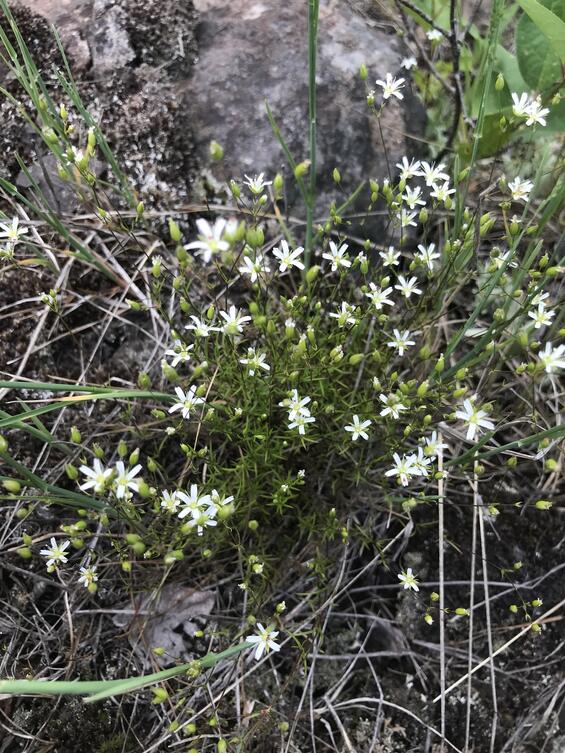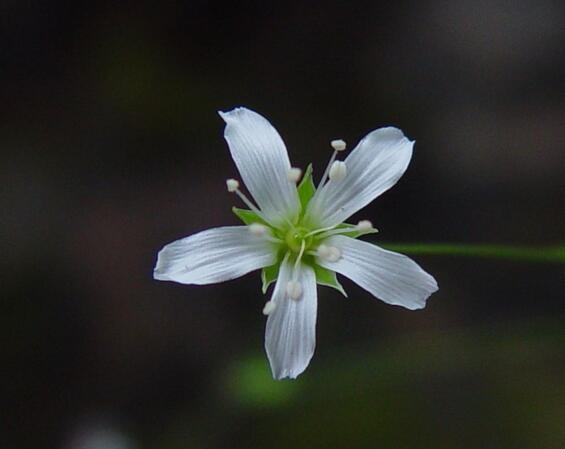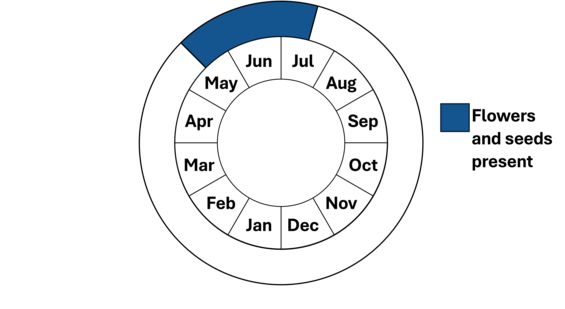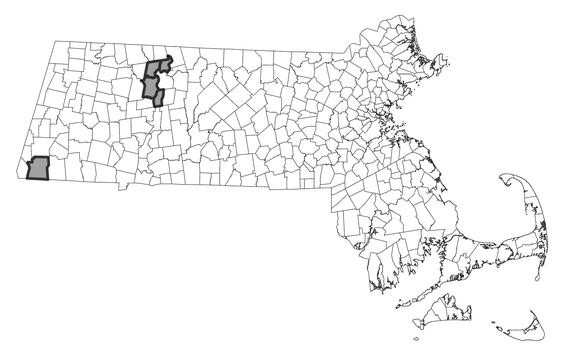- Scientific name: Sabulina michauxii (Fenzl) Dillenb. & Kadereit
- Synonymy: Minuartia michauxii (Fenzl) Farw., Arenaria stricta Michx.
- Species of Greatest Conservation Need (MA State Wildlife Action Plan)
- Threatened (MA Endangered Species Act)
Description

Photo credit: Adam Kohl
Michaux’s sandwort (Sabulina michauxii) is a perennial cespitose herb of the pink family (Caryophyllaceae) and reaches a height of 8-30 cm (3-12 in). It has slender, wiry, forking, smooth stems that spread laterally to a length of 10.5-30 cm (4-12 in) and form loose mats. The plant has fascicles of short primary and secondary needle-like leaves (1.5-3 cm [0.6-1.3 in] in length), which lack stipules, and are rigid and strongly ribbed. Flowering branches are smooth, with numerous bundles of leaves and 3 to 30 widely-branched flowers. The flowers are terminal, borne on long pedicels, with five white petals and small yellow centers. The sepals are 4-5 mm (0.2-0.3 in) long, broadly lance-shaped, acute, and ribbed. The petals are entire, oblong-ovate in shape, and are 5-8 mm, twice as long as the sepals. The fruit capsule is narrowly egg-shaped, solid, with entire valves. The seeds are very small (0.7-0.8 mm [<0.1 in] in length), wrinkled and nearly black in color.
Michaux’s sandwort is the only species of this genus in Massachusetts. Ledge-chickweed (Cerastium arvense) is another plant which may be found in rich, rocky habitat and which superficially resembles Michaux’s sandwort in that it can have fascicles of firm, elongate leaves; however, it has obviously notched petals.

Photo credit: Arthur Haines, Native Plant Trust
Life cycle and behavior
Michaux’s sandwort has bright white flowers that bloom from late May into July. The capsules form quickly after flowering; some will be found while the plants are still flowering. The exact pollinators are not known, but are likely to be flying insects, including bees, flies and butterflies.

Population status
Michaux’s sandwort is listed under the Massachusetts Endangered Species Act as Threatened. All listed species are protected from killing, collecting, possessing, or sale and from activities that would destroy habitat and thus directly or indirectly cause mortality or disrupt critical behaviors. There are currently 9 occurrences of Michaux’s sandwort in the state verified since 1999. Michaux’s sandwort is currently known from Berkshire and Franklin Counties and is historically known from Hampshire County. Only two of the known populations have been ranked as doing well, with good numbers, healthy plants and few invasives.

Distribution in Massachusetts
1999-2024
Based on records in the Natural Heritage Database
Distribution and abundance
Michaux’s sandwort has a patchy distribution throughout North America. It is known from the Canadian provinces of Ontario and Quebec then south to Alabama, New Mexico, and Texas. It is considered of concern in many states, including presumed extirpated in Delaware, critically imperiled in Arkansas, imperiled in Indiana, Maryland, Ohio, Pennsylvania, West Virginia, and Quebec. In New England, it is critically imperiled in Maine and New Hampshire, imperiled in Massachusetts, apparently secure in Vermont and has no status rank in Connecticut and Rhode Island.
Habitat
In Massachusetts, Michaux’s sandwort occurs in the western part of the state on thin, dry, rocky or gravely soils, often on limestone, traprock, or sandstone ledges with significant sun exposure. Associated species include eastern red cedar (Juniperus virginiana), rock spikemoss (Selaginella rupestris), wild columbine (Aquilegia canadensis), harebell (Campanula rotundifolia), field chickweed (Cerastium arvense), tall cinquefoil (Potentilla arguta), poverty-grass (Danthonia spicata), and little bluestem (Schizachyrium scoparium).
Healthy habitats are vital for supporting native wildlife and plants. Explore habitats and learn about conservation and restoration in Massachusetts.
Threats
Michaux’s sandwort requires sun exposure; therefore, habitat succession to dense woody vegetation, caused by the exclusion of natural or anthropogenic disturbance, often casts too much shade. Invasive exotic plant species may over-shade or out-compete Michaux’s sandwort at some sites. Plants along trails may be threatened by trampling damage. Little is known regarding effects of climate change on this species.
Conservation
Survey and monitoring
Regular survey and monitoring of populations and assessment of threats to its populations and habitat are needed. The best time to survey Michaux’s sandwort is when it is in flower, mid-May to mid-July. Populations may be difficult to survey as they can occur on steep rock faces.
Management
As with many rare species, the exact management needs of Michaux’s sandwort are not known. Sites should be monitored for over-shading caused by habitat succession to dense shrub or tree cover, and for invasive exotic species. If trampling or erosion are threats in recreational areas, trails can be stabilized or re-routed. To avoid inadvertent harm to rare plants, all active management of rare plant populations (including invasive species removal) should be planned in consultation with the MassWildlife’s Natural Heritage & Endangered Species Program.
Research needs
Surveys are also needed for Michaux’s sandwort in areas that have potential habitat, particularly near areas where the species was found previously but hasn’t been found recently. It would be helpful to know what species pollinate Michaux’s sandwort and know how common the pollinator is.
References
Fernald, M. L. 1950. Gray’s Manual of Botany, Eighth (Centennial) Edition—Illustrated. American Book Company, New York.
Gleason, Henry A., and Arthur Cronquist. Manual of Vascular Plants of Northeastern United States and Adjacent Canada, Second Edition. Bronx, NY: The New York Botanical Garden, 1991.
Haines, A. 2011. Flora Novae Angliae – a Manual for the Identification of Native and Naturalized Higher Vascular Plants of New England. New England Wildflower Society, Yale Univ. Press, New Haven, CT.
NatureServe. 2025. NatureServe Network Biodiversity Location Data accessed through NatureServe Explorer [web application]. NatureServe, Arlington, Virginia. Available https://explorer.natureserve.org/. Accessed: 4/9/2025.
POWO (2025). Plants of the World Online. Facilitated by the Royal Botanic Gardens, Kew. Published on the Internet; https://powo.science.kew.org/ Accessed: 4/9/2025.
Rabeler, Richard K., Ronald L. Hartman, Frederick H. Utech. “Minuartia michauxii” in Flora of North America online, 2020. http://floranorthamerica.org/Minuartia_michauxii Accessed 4/9/2025.
Seymour, Frank C. 1969. The Flora of New England, First edition. Charles E. Tuttle Company, Inc. Tokyo, Japan.
Contact
| Date published: | May 8, 2025 |
|---|